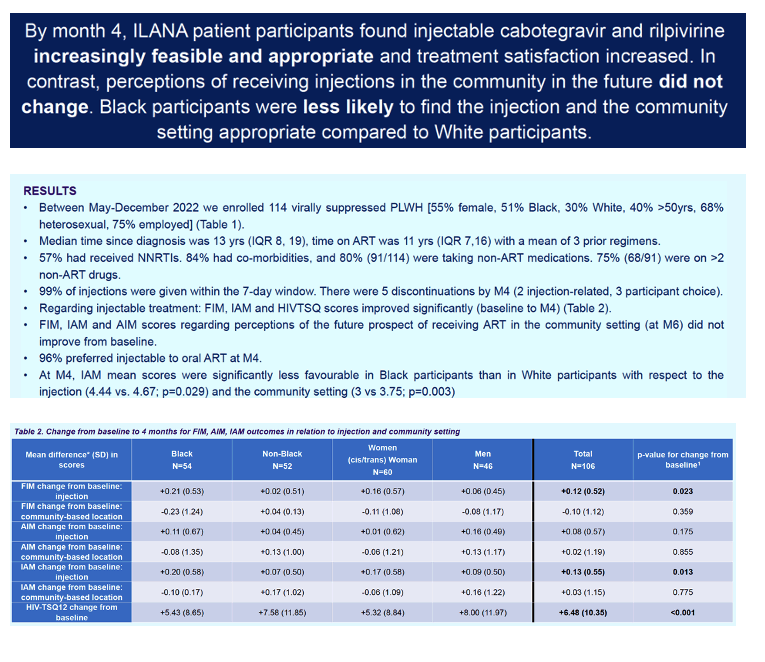 |
 |
 |
| |
Long-Acting CAB + RPV Gains Favor in UK Community, But Less in Blacks
|
| |
| |
CROI 2024 (Conference on Retroviruses and Opportunistic Infections), March 3-6, 2024, Denver
Mark Mascolini
Through 4 months in 2022, a diverse group of people with HIV viewed long-acting injectable cabotegravir (CAB) plus rilpivirine (RPV) as increasingly feasible and appropriate, according to Chloe Orkin and colleagues in the UK ILANA study group [1]. But overall prospects of receiving long-acting CAB + RPV in a community setting in the future did not improve through 6 months, and black participants mustered less enthusiasm for long-term injected antiretrovirals than nonblacks.
This analysis involved 114 adults with well-controlled HIV infection in and around London who switched from oral antiretroviral therapy (ART) to CAB + RPV injected every 2 months from May to December 2022. Participants answered questionnaires when they entered the ILANA group and 4 months later to yield four metrics in the clinic or in a community setting: feasibility of the intervention measure (FIM), acceptability of the intervention measure (AIM), intervention appropriateness measure (IAM), and HIV Treatment Satisfaction Questionnaire (HIVTSQ-12).
More than half of participants (54%) were female, 51% black, 30% white, 5% Asian, and 14% mixed or other races. Four in 10 people were older than 50 years, 68% were heterosexual, 81% employed, and 72% had enough money to cover basic needs. A large majority of participants (84%) had comorbidities, 80% were taking non-ART medications, and 57% had taken nonnucleosides. People received almost all injections (99%) within a 7-day treatment window.
Five participants (4.4%) stopped CAB + RPV in the first 4 months of treatment, 2 because of injection site reactions and 3 just because they decided to quit.
From the start of treatment to month 4, the researchers recorded significant improvements in average scores for FIM (+0.12, P = 0.023), IAM (+0.13, P = 0.013), and HIVTSQ-12 (+6.48, P < 0.001). Almost everyone (96%) preferred getting injections every 2 months to taking pills. In other words, the ILANA team explained, after 4 months of injections participants found the regimen "increasingly feasible and appropriate and treatment satisfaction increased." But perceptions of getting injections in the community 6 months after starting [FIM, IAM, and AIM] did not change"
The study also found race- and gender-based differences in intervention appropriateness (IAM) at month 4: IAM scores of black participants reflected positive feelings about whether injections are appropriate for people with HIV, but IAM scores among blacks indicated significantly less enthusiasm for injection therapy than nonblacks professed in both the clinic (+4.44 vs +4.67, P = 0.029) and the community setting (+3 vs +3.75, P = 0.003). Women tended to have lower average scores than men for AIM change at month 4 in the clinic (+0.01 vs +0.13), AIM change in the community setting (-0.06 vs +0.13), and HIVTSQ-12 (+5.32 vs +8.00).
Reference
1. Orkin C, Haviland J, Wong YL, et al. Implementing LA cabotegravir (CAB) + rilpivirine (RPV) therapy in six UK clinics and in the community. CROI 2024 (Conference on Retroviruses and Opportunistic Infections). March 3-6, 2024. Abstract 621.

|
| |
|
 |
 |
|
|